Quartz-Enhanced Photoacoustic Sensor for Methane
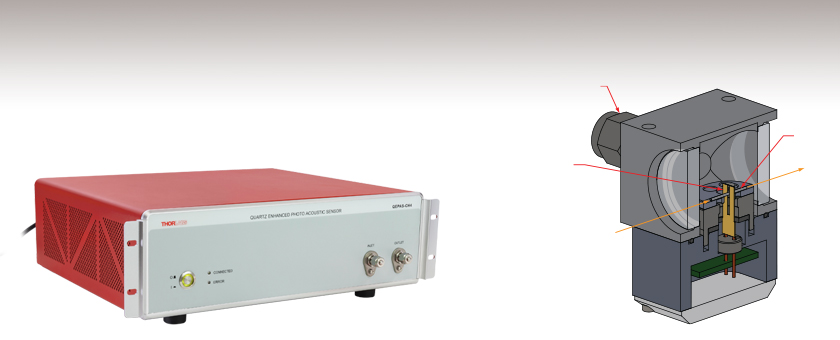
- Complete Quartz-Enhanced Photoacoustic Spectroscopy (QEPAS) System
- Designed to Measure Methane Concentrations from <0.5 ppm to 10,000 ppm
- Calibrated for Synthetic Air and Nitrogen Gas Matrixes with 1,000 ppm to 32,000 ppm Water Vapor
- System Designed for Benchtop or 19" Rack Mount
Gas Inlet
Tube
Laser
Quartz Tuning ForkQEPAS-CH4
QEPAS System for Methane Detection
See Overview and QEPAS Tabs for More Details

Please Wait
| Key Specifications | |
|---|---|
| CH4 Measurement Rangea | <0.5 ppm to 10,000 ppm |
| H2O Range | 1,000 ppm to 32,000 ppm (3.5 % to 99% Relative Humidityb) |
| Minimum Detection Limit | <0.5 ppmc |
| Response Time | 30 sec |
| Input Pressure Range | 750 mbar to 1050 mbar (562 Torr to 787 Torr) |
| Sample Volume | 20 cm3 |
| Operating Temperature Range | 15 ºC to 35 ºC |
| Gas Line Input | 6 mm Swagelok® Tube Fittingd |
| Dimensions (W x D x H) | 482.6 mm x 395.7 mm x 149.8 mm (19.00" x 15.58" x 5.90") |
Features
- Detects Methane Concentrations from <0.5 ppm to 10,000 ppm*
- Calibrated for Use in Synthetic Air and Nitrogen Gas Matrixes
- Accurate Measurements with Gas Matrix Water Concentrations from 1,000 ppm to 32,000 ppm
- Small Gas Sample Volume of 20 cm3
- Simple, "All-in-a-Box" Design
- Included Software with Intuitive GUI Interface
Applications
- Oil and Gas Research
- Pipeline Leakage Detection
- Chemical Analysis
- Trace Gas Sensing
- Environmental Monitoring
- Atmospheric Chemistry
Thorlabs' Quartz-Enhanced Photoacoustic Spectroscopy (QEPAS) Sensor is a compact and complete system for methane (CH4) detection. It features a robust design that does not require any user alignment and is ready to use out-of-the-box; by simply connecting the target gas sample to the QEPAS-CH4 sensor and using our QEPAS Software, methane concentrations from <0.5 ppm to 10,000 ppm* can be measured with an accuracy of ±5% and <0.17 ppm signal noise (at concentrations <5 ppm).
The QEPAS-CH4 sensor features an "all-in-a-box" design and is equipped with all necessary components for methane detection. The test gas is connected to the front panel of the sensor, and internal pressure and flow controllers direct the gas to our ADM01 Acoustic Detection Module. An internal laser centered at the CH4 absorption line excites the target gas molecules, and the quartz tuning fork (QTF) of the ADM01 module detects the pressure waves as the molecules relax. The amplitude of the QTF signal, which is directly proportional to the methane concentration, is measured by an internal DAQ-card and the concentration is clearly displayed in the QEPAS Software. For more information on the operating principles of QEPAS, please see the QEPAS tab.
The signal of a QEPAS measurement is strongly dependent on the amount of water vapor in the gas matrix. Collision with water molecules provides an additional relaxation pathway for the excited target molecules, thereby increasing the QEPAS signal. The QEPAS-CH4 sensor is calibrated to adjust the QEPAS signal for the presence of water using a built-in water sensor to continuously measure the concentration in real-time. This allows accurate and precise methane detection measurements to be performed in the presence of water with concentrations ranging from 1,000 ppm to 32,000 ppm. Each sensor comes with a specification sheet that includes a thorough statistical analysis of the QEPAS-CH4 sensor performance under a wide range of experimental conditions.
Mounting
The QEPAS-CH4 sensor housing is designed for use with a standard 19" equipment rack and includes two mounting brackets. Each bracket has two slots for standard rack mounting screws, which are not included. Alternatively, the sensor includes four rubber feet for benchtop use.
Gas Interface
The QEPAS-CH4 sensor is designed to detect methane in either synthetic air or nitrogen gas matrixes. As shown in the photo above, the front panel is equipped with two gas connection ports, each with 6 mm Swagelok® tube fitting for use with 6 mm OD tubing (not included). The inlet is connected to the target gas being measured and the outlet is connected to a vent. A 2 μm particle filter (not included) is recommended for the gas input. The QEPAS-CH4 comes equipped with all other necessary components for gas flow inside the sensor box, including a pressure controller, flow controller, and vacuum pump.
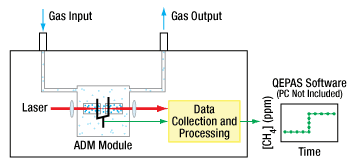
Click for Details
Schematic Diagram of the QEPAS-CH4 Methane Sensor
System Components
The QEPAS-CH4 sensor comes equipped with all electronic components needed to detect methane inside the sensor box, including the laser, laser controller, ADM01 module, and DAQ-card for data collection and processing (see schematic diagram to the left). Additionally, the QEPAS-CH4 system features a sensor to continuously monitor the concentration of water vapor within the gas matrix and subsequently compensate for its influence on the QEPAS signal.
Software
The QEPAS Software is required for operation of the QEPAS-CH4 sensor, which connects to the PC (not included) via USB or Ethernet. The QEPAS Software features a user-friendly GUI interface. Appropriate experimental parameters, such as the data collection rate, presence or absence of oxygen in the gas matrix, and the sensor sensitivity can be defined for highly accurate and precise concentration measurements under a variety of experimental conditions. This powerful software allows methane concentrations to be measured in real time, statistics to be calculated for user defined time ranges, and provides a Data Viewer to view and analyze previously recorded measurements. Please see the Software tab for more information regarding the QEPAS Software.
We cordially thank the PolySense research lab for discussions on the underlying physics of QEPAS.
*The minimum detection limit is for a 1 second integration time. The exact value is available with the sensor specification sheet.
| General Specifications | |
|---|---|
| Gasline Inputa | 6 mm Swagelok® Tube Fitting |
| Supply Voltage | 100 VAC to 240 VAC, 50/60 Hz |
| Operating Temperature Range (Device) | 15 ºC to 35 ºC |
| Operating Temperature Range (Sample) | 15 ºC to 35 ºC |
| Transport and Storage Temperature Range | -20 ºC to 70 ºC |
| Dimensions (W x D x H) | 482.6 mm x 395.7 mm x 149.8 mm (19.00" x 15.58" x 5.90") |
| Weight | 10 kg |
| Key Performance Indicatorsa | ||
|---|---|---|
| Key Indicator | CH4 in Nitrogen | CH4 in Synthetic Air |
| Accuracyb | -5 to 5% | -5 to 5% |
| Precisionc (3σ) | 15% | 15% |
| Noise-on-Peakd (1σ) | <0.17 ppm | <0.17 ppm |
| Limit of Detectione (3σ) | <0.5 ppm | <0.5 ppm |
| QEPAS-CH4 Specifications | |
|---|---|
| Sensor Connection | |
| USB | Type B, 2.0 |
| LAN | RJ45 Cat 7 |
| Sensor | |
| CH4 Measurement Rangea | <0.5 ppm to 10,000 ppm |
| H2O Measurement Range | 1,000 ppm to 32,000 ppm (3.5% to 99% Relative Humidityb) |
| Input Pressure Range | 750 mbar to 1050 mbar (562 Torr to 787 Torr) |
| Gas Flow in Measurement Mode | 20 sccm |
| Maximum Gas Flow for Purging | 500 sccm |
| Downtimec | 25 sec |
| CH4 Response Timed | 30 sec |
| H2O Response Timee | 60 sec |
| Sample Volume | 20 cm3 |
Software
The QEPAS-CH4 Methane Sensor requires the QEPAS Software for operation. The software features a straightforward, intuitive interface and includes a GUI for monitoring methane concentration, setting measurement parameters, logging data, and calculating statistics. Click the software link below to download the latest version of the QEPAS-Software package. Details on the software and a guide to installation and settings can be found in the manual.
| Hardware Requirements | |
|---|---|
| Operating System | Windows® 10 (64-Bit) |
| Processor (CPU) | 1 GHz or Higher |
| Memory (RAM) | 2 GB |
| Graphics Card Resolution (Min) | 1024 x 768 |
| Hard Drive (Min) | 2 GB of Available Space |
| Interface | Free USB 2.0 Port or Ethernet Port |
Software
QEPAS Software Version 1.0.0
The QEPAS Software is required to operate the QEPAS-CH4 methane sensor.
QEPAS Software Highlights
Methane Concentration Measurements
The QEPAS Software is used to measure the concentration of methane in synthetic air or nitrogen gas matrixes. Several key experimental parameters can be defined within the software to provide the most accurate measurement for the given experimental conditions. These parameters include the data collection rate, the presence or absence of oxygen in the gas matrix, and the sensor sensitivity, which can be set to "High" or "Low" depending on the methane concentration being measured. Note that the sensitivity range can also be automatically adjusted by the software. Data and experimental parameters can be exported to CSV format within the software and can be viewed post-experiment using the Data Viewer.
Built-In Tools for Statistical Analysis
Statistical analysis can be performed on the measured methane concentrations over user-defined time ranges. These statistical parameters include the minimum, maximum, mean, and standard deviation of the detected methane. These calculations can be performed on the current QEPAS measurement or on previous measurements using the Data Viewer, and the corresponding analysis can be exported to CSV format within the software.
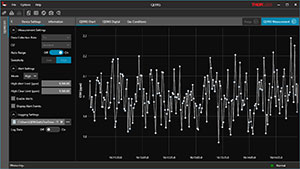
Click for Details
Software parameters such as the data collection rate, presence or absence of oxygen, and the sensor sensitivity can be tailored to match experimental conditions and provide accurate measurements of methane concentrations down to <0.5 ppm.
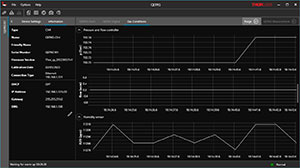
Click for Details
The pressure and flow of the target gas can be monitored in the QEPAS Software. The user can also monitor the water concentration within the gas matrix, which the software will compensate the QEPAS signal for to provide an accurate methane concentration.
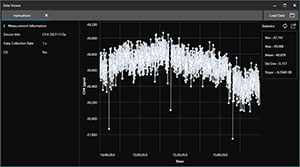
Click for Details
Statistical analysis can be performed on user-defined time ranges and exported within the software. Shown here is the statistical analysis of a data set using the QEPAS Software Data Viewer, which can be used to view and analyze previous experiments.
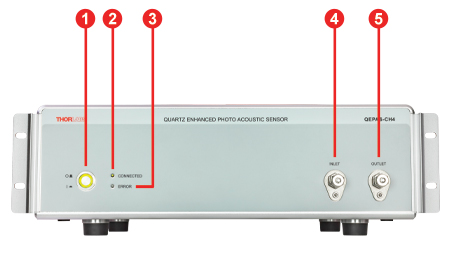
Click to Enlarge
QEPAS-CH4 Front Panel
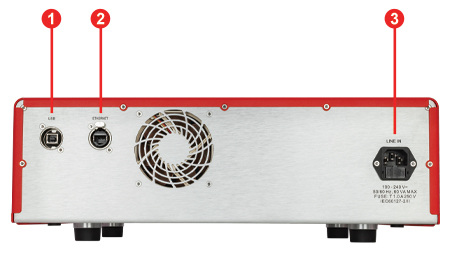
Click to Enlarge
QEPAS-CH4 Back Panel
| Front Panel | |
|---|---|
| Callout | Description |
| 1 | Power Button |
| 2 | Connection Status LED |
| 3 | Error Status LED |
| 4 | Gas Inlet |
| 5 | Gas Outlet |
| Back Panel | |
|---|---|
| Callout | Description |
| 1 | USB 2.0 Type B Port |
| 2 | Ethernet Port |
| 3 | Power Inlet |
The following parts are included with each QEPAS-CH4 sensor:
- QEPAS-CH4 Sensor with 19" Rack Brackets
- 2 Swagelok Closing Caps, 6 mm
- 2 Swagelok Fittings, 6 mm (1 Nut, 1 Front Ferrule, 1 Back Ferrule)
- Region-Specific Power Cord, 1.5 m
- USB 2.0 Cable, 2 m
- RJ45 CAT 7 LAN Cable for Ethernet Connection, 2 m
- Quick Reference
- Sensor Specification Sheet
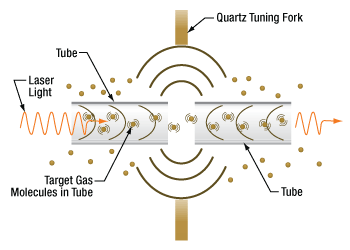
Click to Enlarge
QEPAS Diagram
Photoacoustic spectroscopy is a technique based on the photoacoustic effect that is able to accurately detect trace gas concentrations for a wide variety of applications. Similar to laser absorption spectroscopy, a laser beam is sent through a gastight chamber to excite the target gas molecules. However, instead of detecting the absorption lines with an optical detector, the pressure wave generated by the relaxation of those molecules is detected by a transducer.
In the case of quartz-enhanced photoacoustic spectroscopy (QEPAS), the transducer is a sharply resonant quartz tuning fork (QTF). The high-Q acoustic resonance enables the detection of weak excitation within small volumes, bypassing the acoustic resonance restrictions of conventional methods. When the laser source is modulated with a sine wave, the induced pressure (sound) wave will have double the frequency as that of the light modulation; therefore, the laser source modulation must be at half of the resonance frequency of the QTF. The resulting amplitude from the QTF is directly proportional to the concentration of trace gas in the sample.
The QTF also has good environmental noise immunity due to its being an acoustic quadrupole, since the primary vibrational modes require the prongs to move away from each other to be piezoelectrically active. Sound from external sources has a longer wavelength than the prong separation and will cause the prongs to move in the same direction, resulting in no piezoelectric response.
For more information on the science of QEPAS, please see the Publications tab.
Select Publications on Quartz-Enhanced Photoacoustic Spectroscopy
The following publications provide further information on the principles and applications of QEPAS. For more information, we suggest visiting PolySense, a joint industry-university research lab between Thorlabs and the Technical University of Bari focused on the research and development of innovative optical gas sensing systems.
2023
R. De Palo, A. Elefante, G. Biagi, F. Paciolla, R. Weih, V. Villada, A. Zifarelli, M. Giglio, A. Sampaolo, V. Spagnolo, and P. Patimisco, "Quartz-Enhanced Photoacoustic Sensors for Detection of Eight Air Pollutants," Adv. Photonics Res. 4, 2200353 (2023)
2022
H. Lin, Y. Liu, L. Lin, W. Zhu, X. Zhou, Y. Zhong, M. Giglio, A. Sampaolo, P. Patimisco, F.K. Tittel, J. Yu, V. Spagnolo, and H. Zheng, "Application of standard and custom quartz tuning forks for quartz-enhanced photoacoustic spectroscopy gas sensing," App. Spec. Rev. 57, (2022)
A. Sampaolo, P. Patimisco, M. Giglio, A. Zifarelli, H. Wu, L. Dong, and V. Spagnolo, "Quartz-enhanced photoacoustic spectroscopy for multi-gas detection: A review," Anal. Chim. Acta 1202, 338894 (2021)
2021
P. Patimisco and V. Spagnolo, "Quartz-Enhanced Photoacoustic Spectroscopy for Trace Gas Sensing," Encycl. Anal. Chem. 1-17, (2021)
2020
A. Sampaolo, G. Menduni, P. Patimisco, M. Giglio, V.M.N. Passaro, L. Dong, H. Wu, F.K. Tittel, and V. Spagnolo, "Quartz-Enhanced Photoacoustic Spectroscopy for Hydrocarbon Trace Gas Detection and Petroleum Exploration," Fuel 227, 118118 (2020)
2018
P. Patimisco, A. Sampaolo, L. Dong, F.K. Tittel, and V. Spagnolo, "Recent advances in quartz enhanced photoacoustic sensing," App. Phys. Rev. 5, 011106 (2018)
2016
P. Patimisco, A. Sampaolo, H. Zheng, L. Dong, F.K. Tittel, and V. Spagnolo, "Quartz-enhanced photoacoustic spectrophones exploiting custom tuning forks: a review," Adv. Phys. X 2, 169-187 (2016)
2014
P. Patimisco, G. Scamarcio, F.K. Tittel and V. Spagnolo, "Quartz-Enhanced Photoacoustic Spectroscopy: A Review," Sensors 14, 6165-6206 (2014)
| Posted Comments: | |
| No Comments Posted |
 Products Home
Products Home








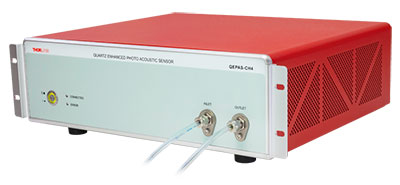

 Quartz-Enhanced Photoacoustic Sensor
Quartz-Enhanced Photoacoustic Sensor